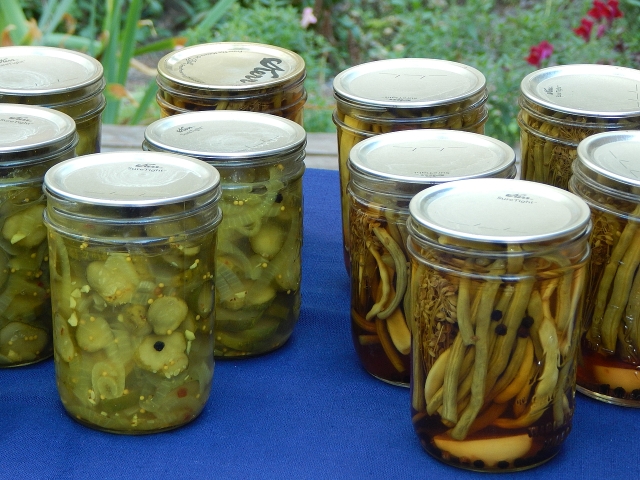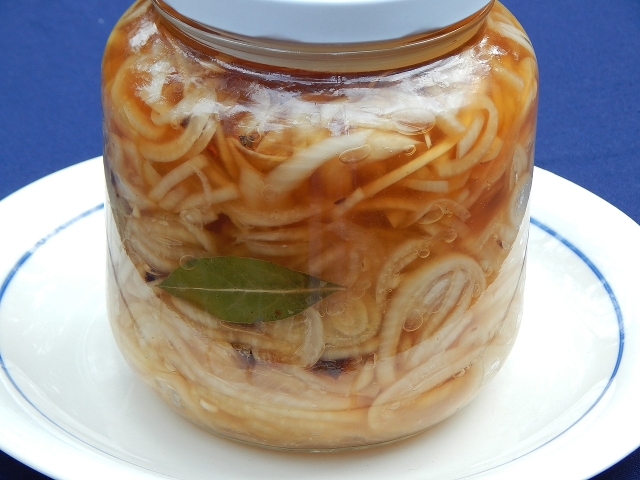
Now that you’re eager to or have successfully made pickles from the recipes in my new cookbook, The Complete Guide to Pickling, where and how should you store them? I talk briefly about pickle storage in the book, but several more tricks and tools will help you keep your pickled foods fresh and crisp.
As I mentioned in my post about pickling hacks earlier this month, you need two basic tools to make and store pickles: a container and a way to cover it. To ensure your pickles and their container stay clean and fresh, inside and out, choose nonreactive containers and lids—in other words, ones made of glass, stainless steel, food-grade plastic, or silicone.
Sure, you can cap your pickles with old metal mayonnaise lids or reuse tin-plated canning lids and rings; I did this, and recommended this repurposing, for years. But both will rust and break down over time as the acid in the pickle brine eats away at them, leaving an unattractive sticky mess around the jar threads, on your refrigerator shelves, and even potentially on the underside of the lid, where it can flake down into the food. Instead, I now save those old lids for dry storage and have switched to nonreactive options for high-acid foods.
The Essentials

Experience has taught me that it’s worth spending a little money on sturdy, nonreactive containers and lids to store pickles. They’re easy to clean and reuse, lasting many seasons. Most importantly, they keep your pickles fresh, crisp, and clean.
My favorite storage containers for pickles are glass, typically Mason jars or larger, wider-mouth gallon jars. I’ve been capping them with several styles of lids, some kindly provided by their manufacturers while I was testing recipes for The Complete Guide to Pickling:
- Stainless-steel rings. For pickles, salsas, chutneys, and other goodies I only plan to refrigerate a few weeks, I pair used canning lids with stainless-steel rings from Mason Jar Lifestyle. They look like standard canning rings but are rustproof and fit either narrow-mouth (regular) or wide-mouth Mason jars.
- Plastic lids. For months-long storage, I switch to a plastic lid. Many companies, from big brands like Ball to small ones like MJL, are creating these for Mason jars, and the best ones have a leakproof silicone seal. My favorites are designed by iLids: the seal is effective without being overly bulky, and their shape makes them easy to open.
- Stainless-steel lids. If you’re cutting back on plastics overall, MJL offers one-piece stainless-steel lids—still with silicone seals to keep your pickle brine from leaking. The logo version and polished vintage version come in narrow-mouth (regular) and wide-mouth sizes.
Canned Pickles

The whole point of canning pickles is to store them in jars with sealed lids on a pantry shelf. As for all home-canned goods, those jars and lids must be specifically designed for canning.
Once your jars have cooled and the flat lids have sealed, remove and wash the rings and wipe down the jars with a damp cloth. Label each jar, listing at least the contents and date. Don’t be tempted to keep the rings on the jars: their purpose was to hold the flat lids in place until they sealed. Once that’s done, they will only be inclined to trap moisture and food particles in the jar threads, potentially leading to rust and mold (this applies to Tattler and other reusable canning lids too, unless the manufacturer’s instructions say otherwise). Store the sealed jars in a cool, dark, dry place—you’re just using up precious space if you keep them in your refrigerator. But once you open them, or if they fail to seal, treat them like refrigerator pickles (see below).
- How to store: In their Mason jar with a sealed canning lid—but remove the ring.
- Where to store: On shelves a cool, dark, dry place, such as a pantry, closet, or mudroom.
Fermented Pickles

If you ferment your pickles in glass jars, it’s easiest to store them in the same vessel. But if you’re using a crock, you’ll want a separate container for storage. Either way, fermented pickles need to be refrigerated (see below); you could can them, but they’ll lose their probiotic goodness and some of their crispness if you process them.
The key rule while you’re fermenting food should be maintained in storage: keep the pickles submerged in brine. I’ve found that most finished ferments sink in brine or can be tucked under jar shoulders, but some need a bit of weight to keep them from rising to the surface and potentially developing mold. If you invested in glass fermentation weights, you can use them during storage. But you can often get away with a lighter weight once the ferment’s done. Invert a narrow-mouth plastic storage lid, slip it into a wide-mouth jar, and let it fill with brine. Or cut the bottom off a yogurt, sour cream, or other plastic container and trim it to size so that you can push it into your storage container.
The final step is to cap your ferment with a nonreactive lid. Some airlock lids can be used for storage: the Sauer System from Fermentology lets you replace the bubble lock with a silicone stopper. A lock-and-pump lid, like Eden Farmhouse’s MasonLock, can stay on the jar as it moves to the fridge. But you’ll be taking that airlock out of the game for weeks to months, during which you could be creating more fermented pickles, so I recommend switching to a storage lid.
- How to store: In a nonreactive container, weighed down as needed, and topped with a nonreactive lid.
- Where to store: In the refrigerator.
Refrigerated Pickles

At some point, all pickles will be refrigerated (unless you can eat an entire batch in one go). Canned pickles must be refrigerated once they’re opened. Putting fermented pickles in the fridge slows the process to a crawl, keeping them at your preferred flavor and crispness. Quick pickles and fresh, unprocessed pickles are made and then stored at fridge temp from day 1.
If you make as many pickles as I do and don’t have a spare fridge stashed in a basement, this presents some challenges. The first is space. Your daily-use refrigerator likely has limited real estate for multimonth pickle storage. I suggest looking at the other long-term fridge residents and deciding who can get the boot. If you ditch commercial salad dressings, sauces, bulky prepackaged foods, and other underused space hogs for fresh variations as you need them, you can free up a surprising amount of room.
The second challenge is weight. Half-gallon jars of fermented cucumbers, carrots, snap beans, and kimchi in brine are heavy. Even the weight of vinegar-pickled quarts jars of zucchini, pears, watermelon rind, and eggs adds up. The first season I got hooked on fermenting, I opened the fridge one day and realized the plastic-edged glass shelves loaded with pickles were bowing under the weight. George resolved the issue before they crashed into a disastrous mess: a piece of 3/4-inch angle aluminum screwed on or riveted to the front edge of each shelf stiffened it enough that I can laden it with 10 brimming half-gallon glass jars.
- How to store: In a nonreactive container with a nonreactive lid.
- Where to store: In the refrigerator, taking into consideration whether your setup has enough space and can support the weight.
Twice as Tasty
 Let’s get pickling! As we approach the post-Thanksgiving, pre-winter holiday shopping and gift-giving season, The Complete Guide to Pickling and The Pickled Picnic should be on your wish list and gifting list. Combine them with some of the products mentioned in this and all of the other November blog posts, and you can create a perfect pickling package.
Let’s get pickling! As we approach the post-Thanksgiving, pre-winter holiday shopping and gift-giving season, The Complete Guide to Pickling and The Pickled Picnic should be on your wish list and gifting list. Combine them with some of the products mentioned in this and all of the other November blog posts, and you can create a perfect pickling package.
Although I’ve included links in these posts to the most accessible source for products, I also encourage you to buy local when you can. Besides ordering a personalized, signed copy of my new cookbook directly from me, these are just a few of the places where you can find The Complete Guide to Pickling: Powell’s Books in Portland, OR; Vintage Books in Vancouver, WA; Village Books in Bellingham; Green Apple Books in San Francisco; Mrs. Dalloway’s Bookstore in Berkeley; The Strand in NYC; Elliot Bay in Seattle; The Last Bookstore in LA; Country Bookshelf in Bozeman; The Well-Read Moose in Coeur d’Alene; Auntie’s Bookstore in Spokane; and Garden District Book Shop in NOLA. In the Flathead Valley, look for it at Bookworks and Trovare in Whitefish, The Bookshelf in Kalispell, and Roma’s Gourmet Kitchen Store in Bigfork. Better yet, join me for Small Business Saturday at Trovare in Whitefish and I’ll sign a copy just for you.
Happy pickling!
Get a signed copy of The Complete Guide to Pickling and the The Pickled Picnic, available exclusively through Twice as Tasty. Click here to order.
The recommendations here are for the tools I use; they are not intended to be an exhaustive review of all available products. Some of the tools I use were kindly provided by their manufacturer

Pingback: Can Pickles Go Bad In The Fridge? - The Whole Portion
So extremely delicious! I’m new to cooking and your instructions were super helpful. I will definitely be coming back and making this again. Thanks u so much.
LikeLike